1997 MERCEDES-BENZ ML320 oil change
[x] Cancel search: oil changePage 2842 of 4133
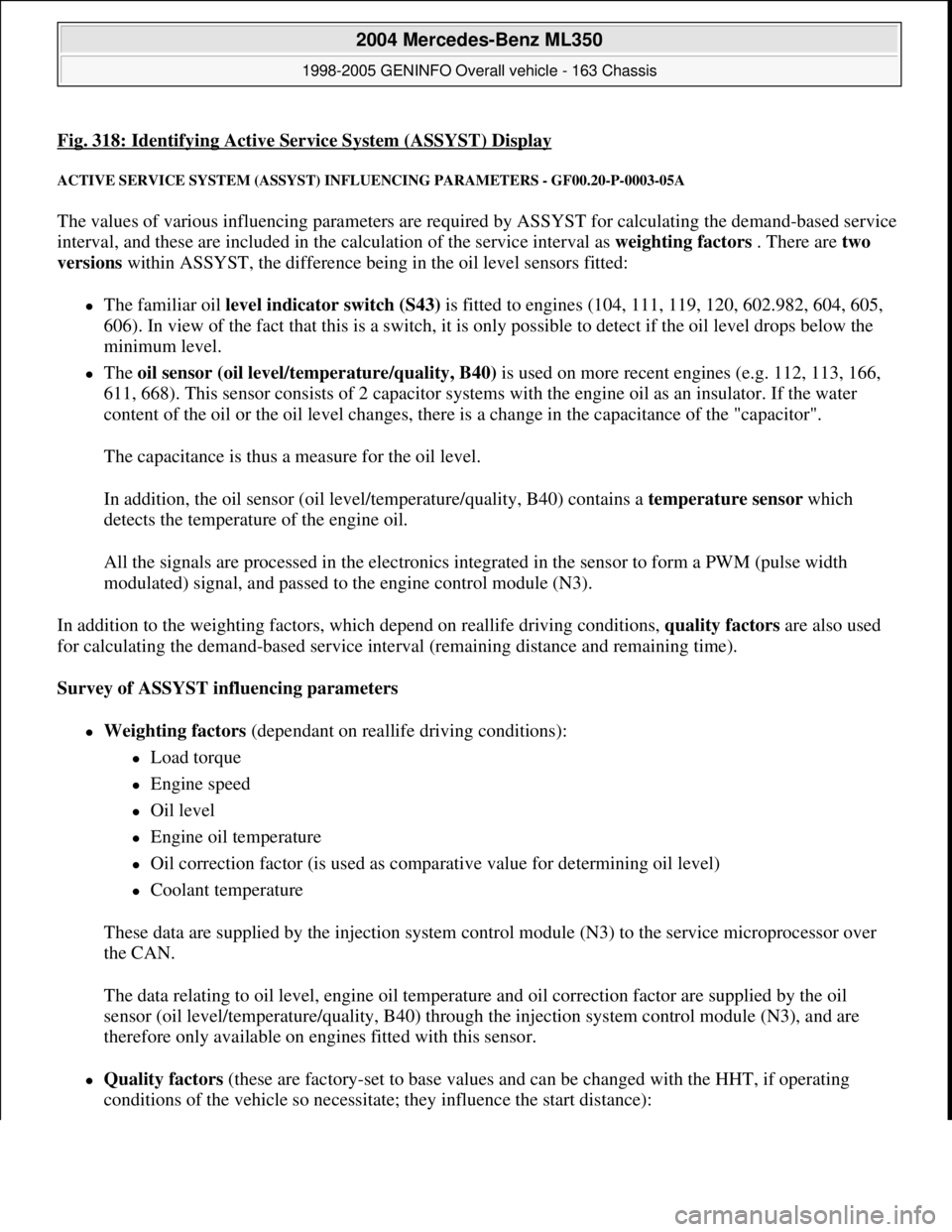
Fig. 318: Identifying Active Service System (ASSYST) Display
ACTIVE SERVICE SYSTEM (ASSYST) INFLUENCING PARAMETERS - GF00.20-P-0003-05A
The values of various influencing parameters are required by ASSYST for calculating the demand-based service
interval, and these are included in the calculation of the service interval as weighting factors . There are two
versions within ASSYST, the difference being in the oil level sensors fitted:
The familiar oil level indicator switch (S43) is fitted to engines (104, 111, 119, 120, 602.982, 604, 605,
606). In view of the fact that this is a switch, it is only possible to detect if the oil level drops below the
minimum level.
The oil sensor (oil level/temperature/quality, B40) is used on more recent engines (e.g. 112, 113, 166,
611, 668). This sensor consists of 2 capacitor systems with the engine oil as an insulator. If the water
content of the oil or the oil level changes, there is a change in the capacitance of the "capacitor".
The capacitance is thus a measure for the oil level.
In addition, the oil sensor (oil level/temperature/quality, B40) contains a temperature sensor which
detects the temperature of the engine oil.
All the signals are processed in the electronics integrated in the sensor to form a PWM (pulse width
modulated) signal, and passed to the engine control module (N3).
In addition to the weighting factors, which depend on reallife driving conditions, quality factors are also used
for calculating the demand-based service interval (remaining distance and remaining time).
Survey of ASSYST influencing parameters
Weighting factors (dependant on reallife driving conditions):
Load torque
Engine speed
Oil level
Engine oil temperature
Oil correction factor (is used as comparative value for determining oil level)
Coolant temperature
These data are supplied by the injection system control module (N3) to the service microprocessor over
the CAN.
The data relating to oil level, engine oil temperature and oil correction factor are supplied by the oil
sensor (oil level/temperature/quality, B40) through the injection system control module (N3), and are
therefore only available on engines fitted with this sensor.
Quality factors (these are factory-set to base values and can be changed with the HHT, if operating
conditions of the vehicle so necessitate; they influence the start distance):
2004 Mercedes-Benz ML350
1998-2005 GENINFO Overall vehicle - 163 Chassis
me
Saturday, October 02, 2010 3:47:47 PMPage 197 © 2006 Mitchell Repair Information Company, LLC.
Page 2848 of 4133
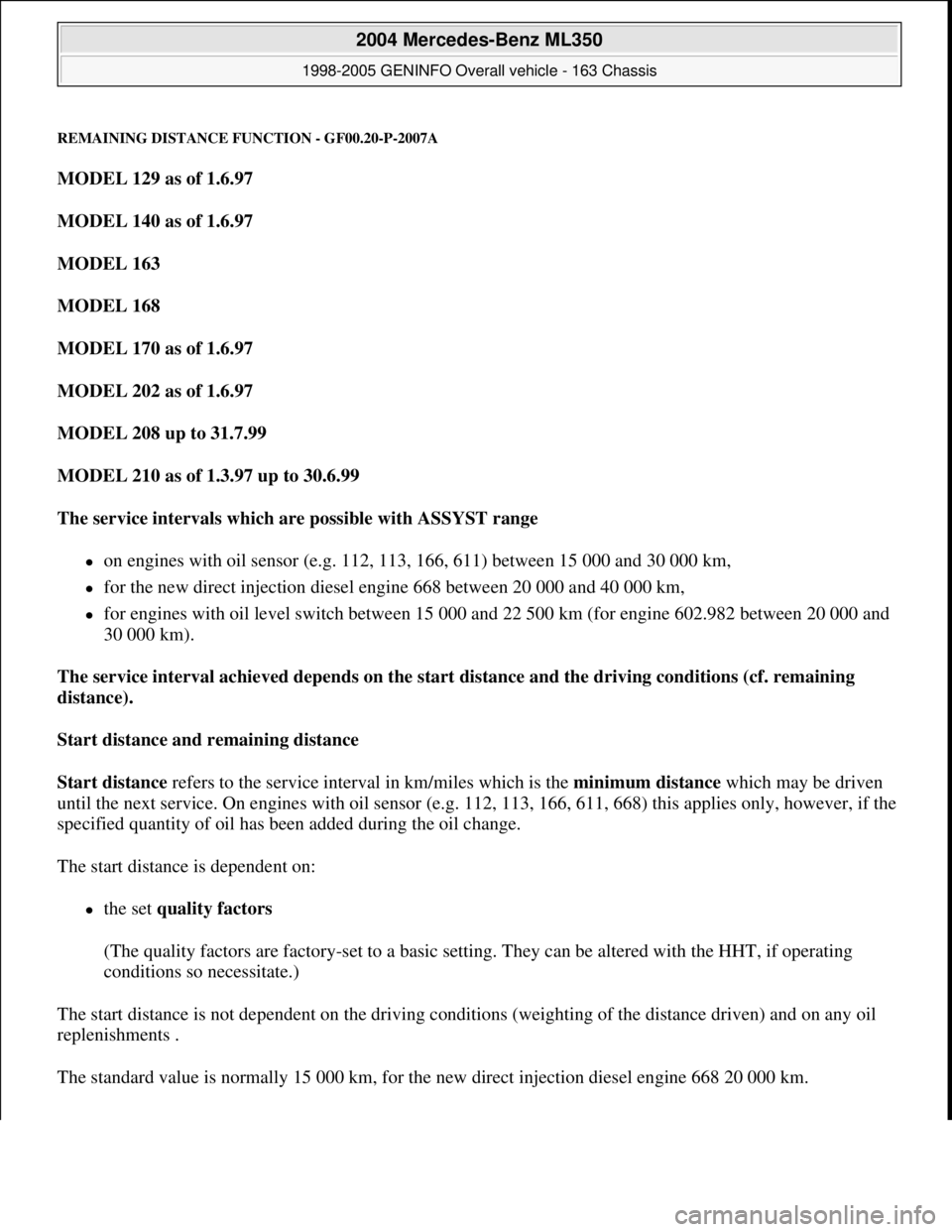
REMAINING DISTANCE FUNCTION - GF00.20-P-2007A
MODEL 129 as of 1.6.97
MODEL 140 as of 1.6.97
MODEL 163
MODEL 168
MODEL 170 as of 1.6.97
MODEL 202 as of 1.6.97
MODEL 208 up to 31.7.99
MODEL 210 as of 1.3.97 up to 30.6.99
The service intervals which are possible with ASSYST range
on engines with oil sensor (e.g. 112, 113, 166, 611) between 15 000 and 30 000 km,
for the new direct injection diesel engine 668 between 20 000 and 40 000 km,
for engines with oil level switch between 15 000 and 22 500 km (for engine 602.982 between 20 000 and
30 000 km).
The service interval achieved depends on the start distance and the driving conditions (cf. remaining
distance).
Start distance and remaining distance
Start distance refers to the service interval in km/miles which is the minimum distance which may be driven
until the next service. On engines with oil sensor (e.g. 112, 113, 166, 611, 668) this applies only, however, if the
specified quantity of oil has been added during the oil change.
The start distance is dependent on:
the set quality factors
(The quality factors are factory-set to a basic setting. They can be altered with the HHT, if operating
conditions so necessitate.)
The start distance is not dependent on the driving conditions (weighting of the distance driven) and on any oil
replenishments .
The standard value is normall
y 15 000 km, for the new direct injection diesel engine 668 20 000 km.
2004 Mercedes-Benz ML350
1998-2005 GENINFO Overall vehicle - 163 Chassis
me
Saturday, October 02, 2010 3:47:47 PMPage 203 © 2006 Mitchell Repair Information Company, LLC.
Page 2849 of 4133

The figure may differ from this, however, depending on quality factors.
The start distance is automatically reset to its initial value by the oil change reset each time the oil is changed.
The start distance is an internal computed quantity and cannot be displayed in the instrument cluster. It is
possible to display the start distance with the HHT.
What is normally displayed in the instrument cluster is the remaining distance .
The remaining distance is the same as the start distance immediately after the oil change. On engines with oil
sensor (e.g. 112, 113, 166, 611, 668) this applies only, however, if the specified quantity of oil has been added
during the oil change.
The remaining distance is the distance which remains from the current kilometer reading until the next
service. The possible length of the interval is at least as great as the remaining distance displayed
immediately after an oil change, and is at the most twice the start distance.
The remaining distance is dependent on
the start distance
the driving conditions (a weighting of the distance driven takes place)
any oil replenishments in the case of engines with oil sensor (e.g. 112, 113, 166, 611, 668)
Consequently, ASSYST also takes into account the driving conditions: In the case of a favorable weighting
(e.g. small number of cold starts, no high engine revs, small number of short-distance trips, minimum extent of
towing a trailer etc.) and oil replenishments, the driver is provided with a bonus which extends the remaining
distance and thus the service interval. Account is also taken of whether the vehicle is actually driven or whether
the engine runs at idle speed. ASSYST is constantly supplied with the data regarding the current operating
conditions of the vehicle for this purpose.
In the case of the best weighting , only 0.6 km are added for each kilometer driven.
In the case of the most unfavorable weighting of the distance (e.g. frequent short-distance trips, large number
of cold starts), the remaining distance and thus the service interval is smaller than in the case of the most
favorable weighting (assuming identical quality factors).
In the case of the most unfavorable weighting, up to 3 km are added for each kilometer driven.
The start distance and the remaining distance are once again presented in the form of a graph in the diagram
opposite, taking the example of gasoline engines
Each time the oil is changed, the start and remaining distances are set to the initial value. In this case, the
normal value of 15 000 km is entered as the start distance (top bar) (shaded + dark section). The start distance
may differ from 15 000 km (e.g. 14 000 km; shaded section) if the quality factors do not correspond to the basic
setting. In the case of engines fitted with oil sensor (e.g. 112, 113, 166) the start distance may also be less than
15 000 km if the specified oil quantity was not added during the oil change. The remaining distance (bottom
bar) is always 15 000 km, however, immediately after an oil change. In addition, the service interval is
always at least 15 000 km .
2004 Mercedes-Benz ML350
1998-2005 GENINFO Overall vehicle - 163 Chassis
me
Saturday, October 02, 2010 3:47:47 PMPage 204 © 2006 Mitchell Repair Information Company, LLC.
Page 2852 of 4133
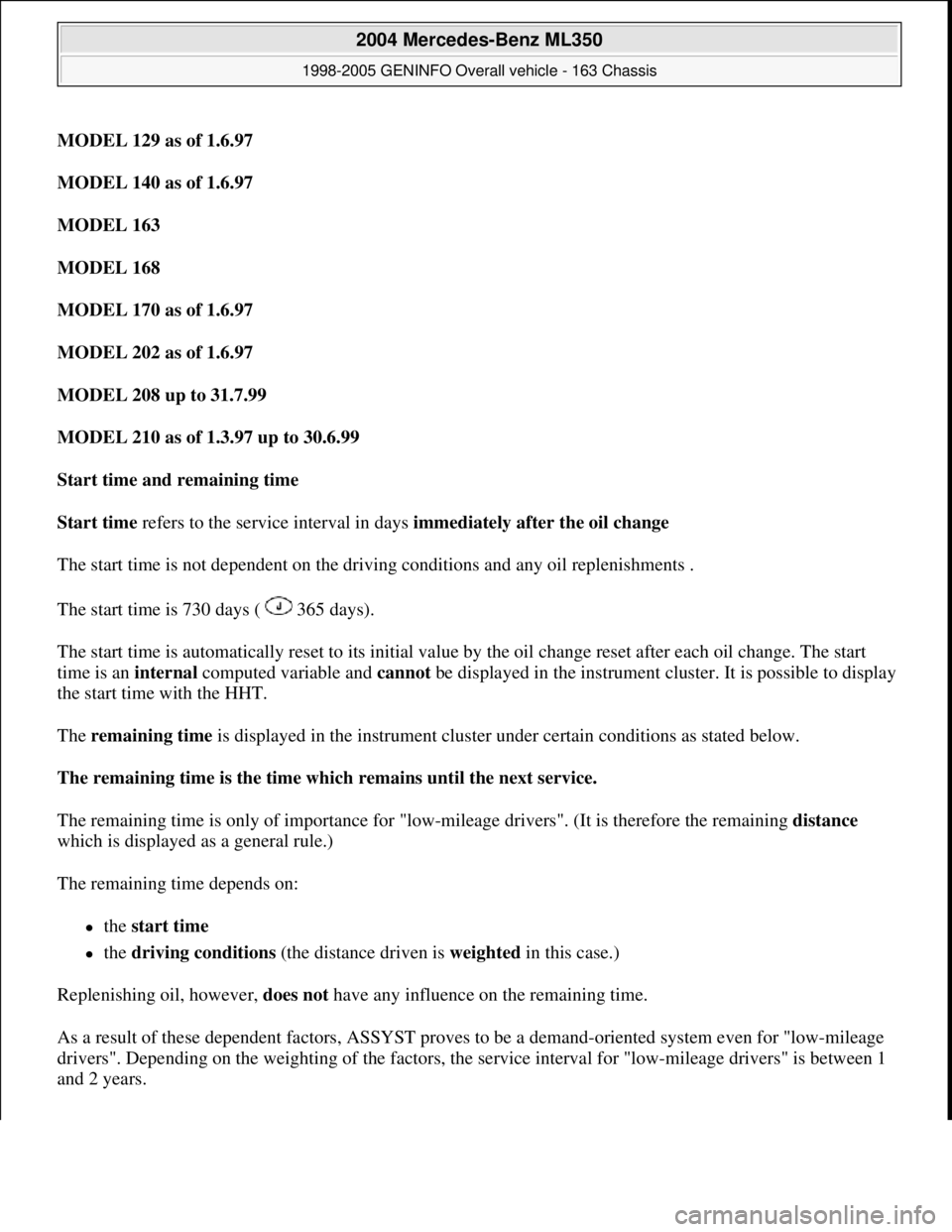
MODEL 129 as of 1.6.97
MODEL 140 as of 1.6.97
MODEL 163
MODEL 168
MODEL 170 as of 1.6.97
MODEL 202 as of 1.6.97
MODEL 208 up to 31.7.99
MODEL 210 as of 1.3.97 up to 30.6.99
Start time and remaining time
Start time refers to the service interval in days immediately after the oil change
The start time is not dependent on the driving conditions and any oil replenishments .
The start time is 730 days ( 365 days).
The start time is automatically reset to its initial value by the oil change reset after each oil change. The start
time is an internal computed variable and cannotbe displayed in the instrument cluster. It is possible to display
the start time with the HHT.
The remaining time is displayed in the instrument cluster under certain conditions as stated below.
The remaining time is the time which remains until the next service.
The remaining time is only of importance for "low-mileage drivers". (It is therefore the remaining distance
which is displayed as a general rule.)
The remaining time depends on:
the start time
the driving conditions (the distance driven is weighted in this case.)
Replenishing oil, however, does not have any influence on the remaining time.
As a result of these dependent factors, ASSYST proves to be a demand-oriented system even for "low-mileage
drivers". Depending on the weighting of the factors, the service interval for "low-mileage drivers" is between 1
and 2
years.
2004 Mercedes-Benz ML350
1998-2005 GENINFO Overall vehicle - 163 Chassis
me
Saturday, October 02, 2010 3:47:47 PMPage 207 © 2006 Mitchell Repair Information Company, LLC.
Page 2855 of 4133
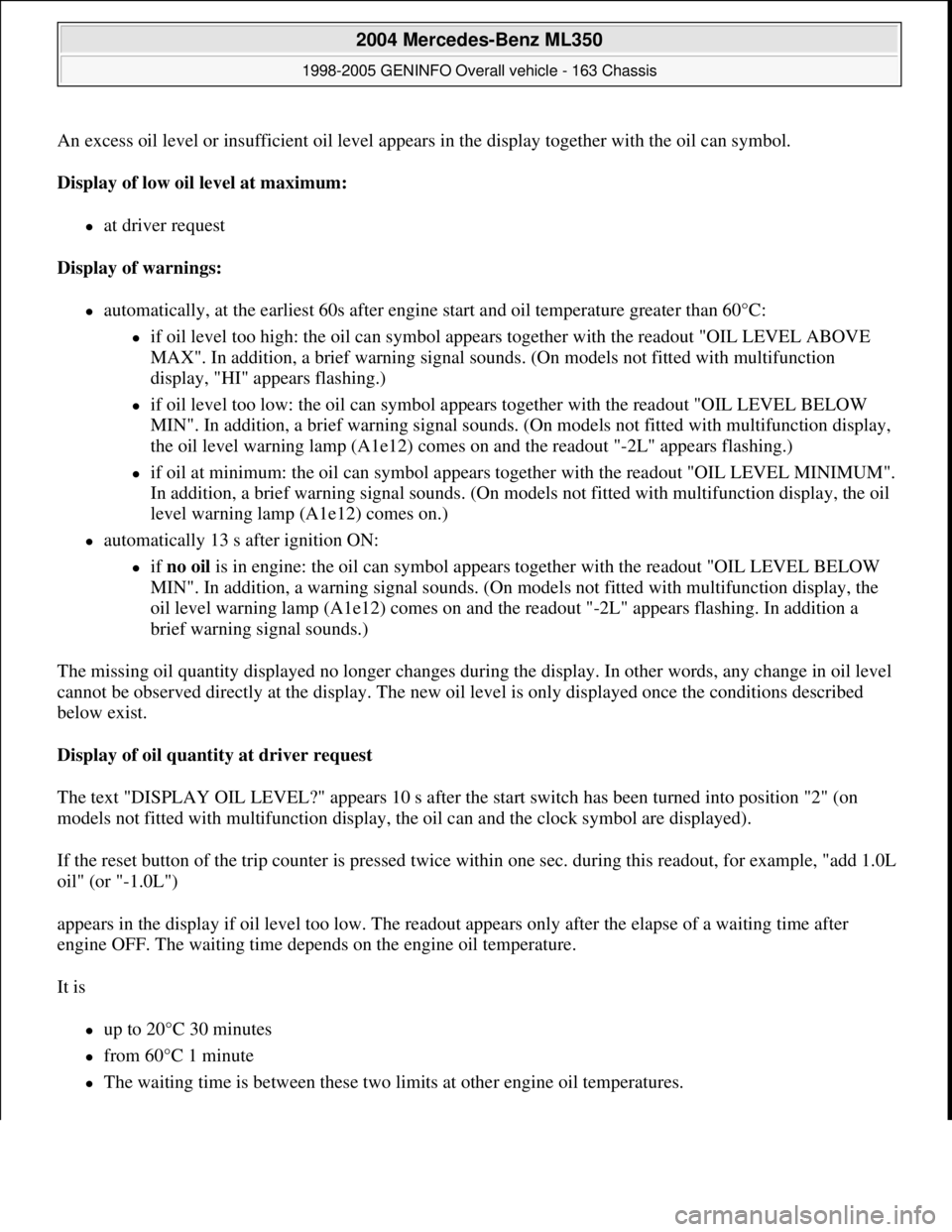
An excess oil level or insufficient oil level appears in the display together with the oil can symbol.
Display of low oil level at maximum:
at driver request
Display of warnings:
automatically, at the earliest 60s after engine start and oil temperature greater than 60°C:
if oil level too high: the oil can symbol appears together with the readout "OIL LEVEL ABOVE
MAX". In addition, a brief warning signal sounds. (On models not fitted with multifunction
display, "HI" appears flashing.)
if oil level too low: the oil can symbol appears together with the readout "OIL LEVEL BELOW
MIN". In addition, a brief warning signal sounds. (On models not fitted with multifunction display,
the oil level warning lamp (A1e12) comes on and the readout "-2L" appears flashing.)
if oil at minimum: the oil can symbol appears together with the readout "OIL LEVEL MINIMUM".
In addition, a brief warning signal sounds. (On models not fitted with multifunction display, the oil
level warning lamp (A1e12) comes on.)
automatically 13 s after ignition ON:
if no oil is in engine: the oil can symbol appears together with the readout "OIL LEVEL BELOW
MIN". In addition, a warning signal sounds. (On models not fitted with multifunction display, the
oil level warning lamp (A1e12) comes on and the readout "-2L" appears flashing. In addition a
brief warning signal sounds.)
The missing oil quantity displayed no longer changes during the display. In other words, any change in oil level
cannot be observed directly at the display. The new oil level is only displayed once the conditions described
below exist.
Display of oil quantity at driver request
The text "DISPLAY OIL LEVEL?" appears 10 s after the start switch has been turned into position "2" (on
models not fitted with multifunction display, the oil can and the clock symbol are displayed).
If the reset button of the trip counter is pressed twice within one sec. during this readout, for example, "add 1.0L
oil" (or "-1.0L")
appears in the display if oil level too low. The readout appears only after the elapse of a waiting time after
engine OFF. The waiting time depends on the engine oil temperature.
It is
up to 20°C 30 minutes
from 60°C 1 minute
The waiting time is between these two limits at other engine oil temperatures.
2004 Mercedes-Benz ML350
1998-2005 GENINFO Overall vehicle - 163 Chassis
me
Saturday, October 02, 2010 3:47:47 PMPage 210 © 2006 Mitchell Repair Information Company, LLC.
Page 2856 of 4133
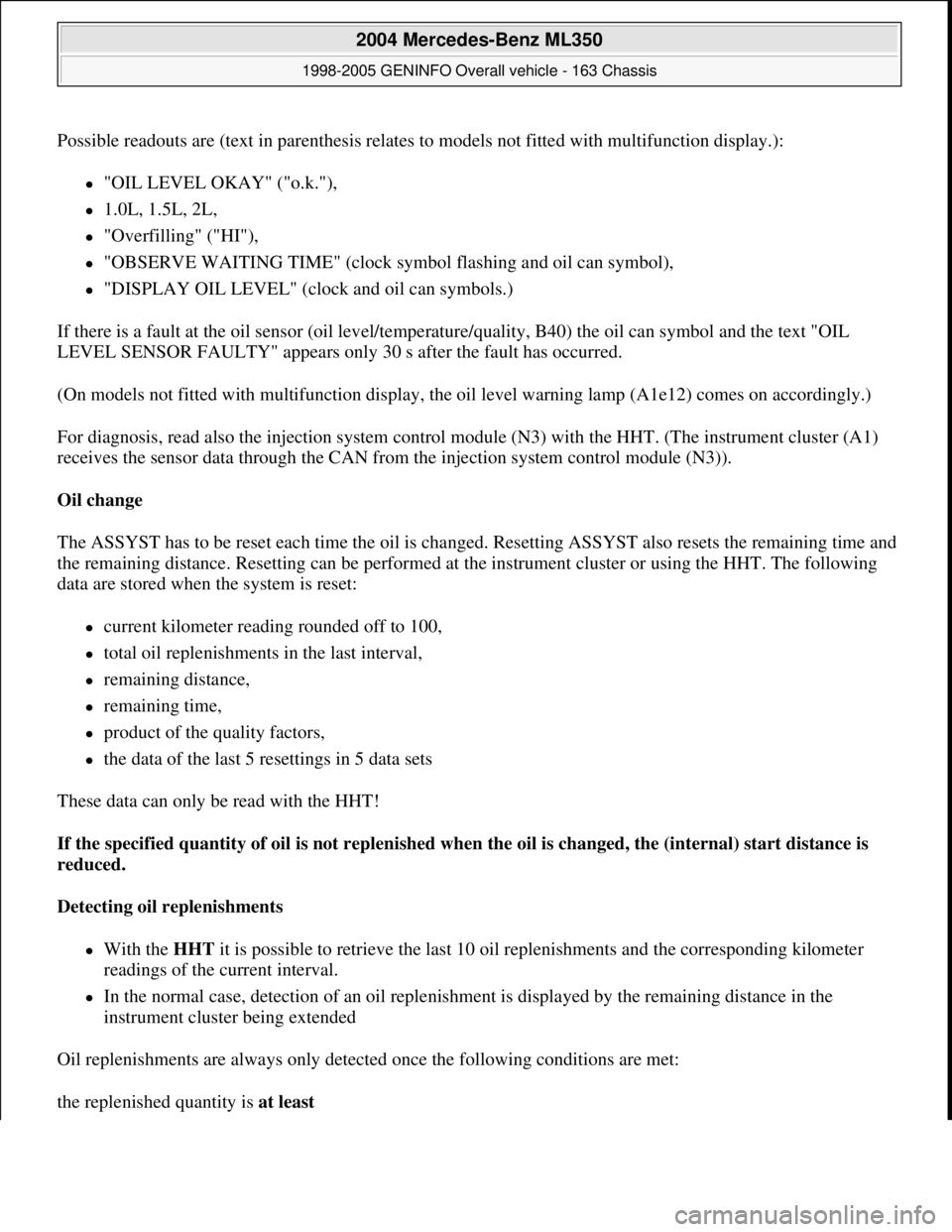
Possible readouts are (text in parenthesis relates to models not fitted with multifunction display.):
"OIL LEVEL OKAY" ("o.k."),
1.0L, 1.5L, 2L,
"Overfilling" ("HI"),
"OBSERVE WAITING TIME" (clock symbol flashing and oil can symbol),
"DISPLAY OIL LEVEL" (clock and oil can symbols.)
If there is a fault at the oil sensor (oil level/temperature/quality, B40) the oil can symbol and the text "OIL
LEVEL SENSOR FAULTY" appears only 30 s after the fault has occurred.
(On models not fitted with multifunction display, the oil level warning lamp (A1e12) comes on accordingly.)
For diagnosis, read also the injection system control module (N3) with the HHT. (The instrument cluster (A1)
receives the sensor data through the CAN from the injection system control module (N3)).
Oil change
The ASSYST has to be reset each time the oil is changed. Resetting ASSYST also resets the remaining time and
the remaining distance. Resetting can be performed at the instrument cluster or using the HHT. The following
data are stored when the system is reset:
current kilometer reading rounded off to 100,
total oil replenishments in the last interval,
remaining distance,
remaining time,
product of the quality factors,
the data of the last 5 resettings in 5 data sets
These data can only be read with the HHT!
If the specified quantity of oil is not replenished when the oil is changed, the (internal) start distance is
reduced.
Detecting oil replenishments
With the HHT it is possible to retrieve the last 10 oil replenishments and the corresponding kilometer
readings of the current interval.
In the normal case, detection of an oil replenishment is displayed by the remaining distance in the
instrument cluster being extended
Oil replenishments are always only detected once the following conditions are met:
the replenished quantit
y is at least
2004 Mercedes-Benz ML350
1998-2005 GENINFO Overall vehicle - 163 Chassis
me
Saturday, October 02, 2010 3:47:47 PMPage 211 © 2006 Mitchell Repair Information Company, LLC.
Page 2857 of 4133

In the charts overleaf, a number of examples of this are presented. The horizontal (x) axis represents the service
interval and the vertical (y) axis is the remaining distance in each case in km.
conditions are met:
the replenished quantity is at least 1 l
after replenishing the oil, the car must be driven a distance of at least 5 km under normal driving
conditions at an oil temperature of at least 60°C
There are instances, however, in which the readout of the remaining distance nevertheless appears implausible
after replenishing oil; according to the display, no bonus or only a small bonus has been issued. This is caused
by the fact that the remaining distance is always only displayed within a range from 15 000 km up to 30 000 km
(or 20 000 km up to 40 000 km in the case of engine 668), but internally the system calculates with the actual
values which may also be beyond this range. These internal values can only be displayed with the HHT.
horizontal (x) axis represents the service interval and the vertical (y) axis is the remaining distance in each case
in km.
The readout of ASSYST in the instrument cluster always moves within the light range.
The remaining distance calculated internally may also, however, be within the two dark ranges. These internal
values can only be displayed with the HHT.
All examples relate to gasoline engines fitted with an oil sensor.
Example 1 :
Sufficient oil was added during the oil change. This means that the starting distance is 15 000 km.
After 10 000 km oil is topped up under normal driving conditions (a). The bonus (B1) is issued and displayed.
What this means is that when the remaining distance is retrieved, a greater remaining distance is displayed.
(Provided the aforementioned conditions for detecting the oil replenishment are met.)
Oil is topped up again after a further 5 000 km (b). In this case also a bonus (B2) is issued and displayed.
If, after this, no further oil is topped up and the car continues to be driven in the same manner, a service interval
of about 24 000 km is thus achieved.
In this example, the curve moves at all points within the light range of the chart; consequently, all the oil
replenishments are displayed by increasing the remaining distance.
2004 Mercedes-Benz ML350
1998-2005 GENINFO Overall vehicle - 163 Chassis
me
Saturday, October 02, 2010 3:47:47 PMPage 212 © 2006 Mitchell Repair Information Company, LLC.
Page 2858 of 4133

Fig. 322: Engine Oil Monitor Function - (1 Of 4)
Example 2:
The specified quantity of oil was added when the oil was changed.
The car is driven under very favorable conditions and oil is topped up after 10 000 km (a). Internally, the bonus
B1 is issued, the service interval is extended accordi ngly by enlarging the remaining distance. However, as the
curve is sometimes within the shaded ar ea, only the part of B1 which is within the light area, is at first displayed
as an extension of the remaining distance. (Provi ded the aforementioned conditions for detecting oil
replenishment are met.)
Oil is topped up once again at 18 000 km (b ). In view of the fact that the maximum service interval of 30 000
km was exceeded, the bonus B2 is not initially displayed as an extension. Th e entire service interval in this case
is 30 000 km.
If, from point b, the car continues to be driven under less favorable conditions , it may still also be possible now
to achieve the maximum service interval of 30 000 km because of the internal bonus B2.
Fig. 323: Engine Oil Monitor Function
- (2 Of 4)
Example 3:
When the oil was changed, the quantity added was less than the specified quantity. Consequently, the start
distance is less than 15 000 km.
2004 Mercedes-Benz ML350
1998-2005 GENINFO Overall vehicle - 163 Chassis
me
Saturday, October 02, 2010 3:47:47 PMPage 213 © 2006 Mitchell Repair Information Company, LLC.